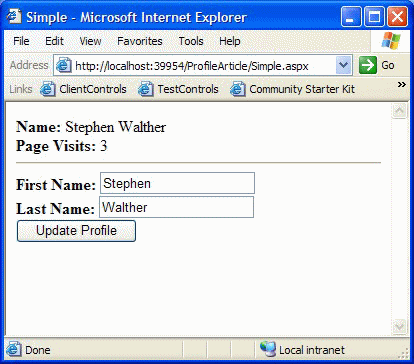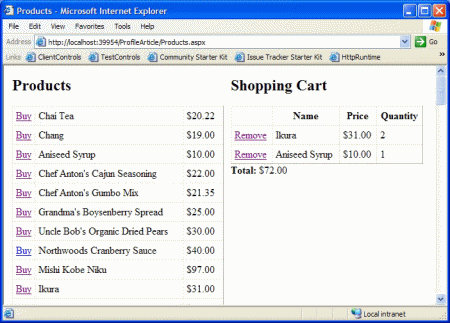强类型 长期保存 支持匿名用户
定义配置(profile)
 <?xml version="1.0"?>
<?xml version="1.0"?>
 <configuration xmlns="http://schemas.microsoft.com/.NetConfiguration/v2.0">
<configuration xmlns="http://schemas.microsoft.com/.NetConfiguration/v2.0"> <appSettings/>
<appSettings/> <connectionStrings>
<connectionStrings> <add name="Northwind" connectionString="Server=localhost;Integrated Security=True;Database=Northwind" providerName="System.Data.SqlClient"/>
<add name="Northwind" connectionString="Server=localhost;Integrated Security=True;Database=Northwind" providerName="System.Data.SqlClient"/> </connectionStrings>
</connectionStrings> <system.web>
<system.web>
 <anonymousIdentification enabled="true" />
<anonymousIdentification enabled="true" /> <profile> //定义配置(profile)
<profile> //定义配置(profile) <properties>
<properties> <add name="Theme" allowAnonymous="true" />
<add name="Theme" allowAnonymous="true" /> <add name="LastVisit" type="System.DateTime" allowAnonymous="true" />
<add name="LastVisit" type="System.DateTime" allowAnonymous="true" /> </properties>
</properties> </profile>
</profile> <!--
<!-- <webParts> //定义配置(webParts)
<webParts> //定义配置(webParts) <personalization defaultProvider="AspNetSqlPersonalizationProvider"/>
<personalization defaultProvider="AspNetSqlPersonalizationProvider"/> </webParts>
</webParts> -->
--> <!--
<!--  Set compilation debug="true" to insert debugging symbols into the compiled page.
Set compilation debug="true" to insert debugging symbols into the compiled page. Because this affects performance, set this value to true only during development.
Because this affects performance, set this value to true only during development. -->
--> <compilation debug="true">
<compilation debug="true"> <expressionBuilders>
<expressionBuilders> <add expressionPrefix="Version" type="VersionExpressionBuilder"/>
<add expressionPrefix="Version" type="VersionExpressionBuilder"/> </expressionBuilders>
</expressionBuilders> </compilation>
</compilation> <!--
<!-- The <authentication> section enables configuration of the security authentication
The <authentication> section enables configuration of the security authentication mode used by ASP.NET to identify an incoming user.
mode used by ASP.NET to identify an incoming user.  -->
--> <authentication mode="Windows"/>
<authentication mode="Windows"/> <!--
<!-- The <customErrors> section enables configuration of what to do if/when an unhandled
The <customErrors> section enables configuration of what to do if/when an unhandled error occurs during the execution of a request. Specifically, it enables developers
error occurs during the execution of a request. Specifically, it enables developers to configure html error pages to be displayed in place of a error stack trace.
to configure html error pages to be displayed in place of a error stack trace. -->
--> <customErrors mode="RemoteOnly" defaultRedirect="GenericErrorPage.htm">
<customErrors mode="RemoteOnly" defaultRedirect="GenericErrorPage.htm"> <!--
<!--  <error statusCode="403" redirect="NoAccess.htm"/>
<error statusCode="403" redirect="NoAccess.htm"/> <error statusCode="404" redirect="FileNotFound.htm"/>
<error statusCode="404" redirect="FileNotFound.htm"/> -->
--> </customErrors>
</customErrors> </system.web>
</system.web> </configuration>
</configuration>
使用配置(profile)
//increment the current user's post cout
profile.posts = profile.posts+1;
// update the current user's last post date
profile.lastpost = datetime.now;
个性化数据将存入数据库
Microsoft ASP.NET 2.0支持被称为Profile的新对象,它可以自动在多个Web应用程序的访问之间存储用户信息。一个User Profile中可以存储各种类型的信息,这些信息既可以是简单的string和integer类型,也可以是复杂的自定义类型。例如,你可以存储用户的姓、购物篮、用户属性或网站使用情况统计。
本文中,你将学习如何在一个应用中定义user profile。我们也会向你演示如何配置使用不同provider的profile。最后,你将学习如何管理和生成user profile的报告。
Profile 对象与Session对象十分相似,但是更好用一些。与Session相似的地方在于,Profile是相对于一个特定的用户的,也就是说,每个Web应用程序的用户都有他们自己的profile对象。与Session不同的是,Profile对象是持久对象。如果你向Session中添加一个项,在你离开网站时,该项就会消失。而Profile则完全不同,当你修改Profile的状态时,修改在多个访问之间均有效。
使用强类型是有它的道理的。例如,使用强类型,你就可以在Microsoft Visual Web Developer中使用智能感知技术,当你键入Profile和一个点的时候,智能感知会弹出你已经定义过的profile属性列表。
你既可以在machine.config中,也可以在web.config中定义一个user profile,由于你不能在应用程序的二级目录中创建一个包含文件profile节的web.config文件,这意味着你将无法在一个应用程序中定义两个以上的profile。
在列表1的web.config中,列举了一个简单的profile定义的实例,该profile有三个属性,FirstName, LastName和PageVisits。
<configuration>
<system.web>
<authentication mode="Forms" />
<anonymousIdentification enabled="true" />
<profile>
<properties>
<add
name="FirstName"
defaultValue="??"
allowAnonymous="true" />
<add
name="LastName"
defaultValue="??"
allowAnonymous="true" />
<add
name="PageVisits"
type="Int32"
allowAnonymous="true"/>
</properties>
</profile>
</system.web>
</configuration>
由于该profile需要同时被匿名用户和已认证用户使用,因此我们在web.config文件中增加包含一个< anonymousIdentification>元素,有了这个元素,系统就会自动为匿名用户生成唯一的ID。仔细看的话我们会发现,每一个 profile属性都有一个allowAnonymous特性,该特性表明这个profile属性是否允许被匿名用户使用。
当你定义好一个profile之后,系统会自动在下一次页面被调用时,生成一个与该profile相对应的类。这个类会被保存在"Temporary ASP.NET Files Directory"目录(该目录也用于存放用于动态生成页面的类)。你可以使用HttpContext的Profile属性(Property)调用该类。
当你定义好一个profile后,你可以使用如下方法为profile属性赋值。
Profile.FirstName = "Bill"
[C#]
Profile.FirstName
列表2演示了你该如何使用profile来持久化保存用户信息。这个页显示了FirstName,LastName, PageVisits三个属性的值,同时它包含了一个能够用于修改这三个属性的表单(form)。在Page_Load中更新PageVisits的值,这意味着每一次刷新页面,PageVisits的值都会改变。

<script runat="server">
void Page_Load() {
Profile.PageVisits ++;
}
void UpdateProfile(Object s, EventArgs e) {
Profile.FirstName = txtFirstName.Text;
Profile.LastName = txtLastName.Text;
}
</script> <html>
<head>
<title>Simple</title>
</head>
<body>
<form id="form1" runat="server">
<b>Name:</b> <%= Profile.FirstName %> <%= Profile.LastName %>
<br />
<b>Page Visits:</b> <%= Profile.PageVisits %>
<hr />
<b>First Name:</b>
<asp:TextBox ID="txtFirstName" Runat="Server" />
<br />
<b>Last Name:</b>
<asp:TextBox ID="txtLastName" Runat="Server" />
<br />
<asp:Button ID="Button1"
Text="Update Profile"
OnClick="UpdateProfile"
Runat="server" />
</form>
</body>
</html>
<configuration>
<system.web>
<anonymousIdentification enabled="true" />
<profile>
<properties>
<group name="Address">
<add
name="Street"
allowAnonymous="true" />
<add
name="City"
allowAnonymous="true" />
</group>
<group name="Preferences">
<add
name="ReceiveNewsletter"
type="Boolean"
defaultValue="false"
allowAnonymous="true" />
</group>
</properties>
</profile>
</system.web>
</configuration>
当你用组来定义profile时,你应该使用组名来设置或读取profile属性。例如,在列表3中,你可以使用以下一些句子来完成三个profile属性的赋值。
Profile.Address.City
= "Modesto";Profile.Address.Street = "111 King Arthur Ln";
Profile.Preferences.ReceiveNewsletter = false;
举个例子,假设你现在需要在profile中存储一个购物篮,如果这样做的话,你就可以在每次访问网站时获得自己的购物篮。
列表4 声明了一个包含profile,这个profile包含一个名为ShoppingCart的属性,而该属性的type特性是一个叫ShoppingCart的类(我们接下来会创建该类),该类名是有效的。
我们还会注意到,该声明中包含一个serializeAs特性,该特性可以帮助ShoppingCart使用二进制序列化器(binary serializer)进行持久化,而不是使用xml序列化器。
<
configuration><system.web>
<anonymousIdentification enabled="true" />
<profile>
<properties>
<add
name="ShoppingCart"
type="ShoppingCart"
serializeAs="Binary"
allowAnonymous="true" />
</properties>
</profile>
</system.web>
</configuration>
列表5 中有一个简单购物篮的实现代码,该购物篮拥有添加和删除项(item)的方法(method),同时它还拥有两个属性(property),一个是用于获得该购物篮中的所有项的,一个是用于表示所有商品的总价的。
using
System;using System.Collections;
[Serializable]
{
public Hashtable _CartItems = new Hashtable();
// Return all the items from the Shopping Cart
//得到购物车中所有的元素
public ICollection CartItems
{
get { return _CartItems.Values; }
}
// The sum total of the prices
// 计算购物车中所有产品总价格
public decimal Total
{
get
{
decimal sum = 0;
foreach (CartItem item in _CartItems.Values)
sum += item.Price * item.Quantity;
return sum;
}
}
// Add a new item to the shopping cart
public void AddItem(int ID, string Name, decimal Price)
{
CartItem item = (CartItem)_CartItems[ID];
if (item == null)
_CartItems.Add(ID, new CartItem(ID, Name, Price));
else
{
item.Quantity++;
_CartItems[ID] = item;
}
}
// Remove an item from the shopping cart
public void RemoveItem(int ID)
{
CartItem item = (CartItem)_CartItems[ID];
if (item == null)
return;
item.Quantity--;
if (item.Quantity == 0)
_CartItems.Remove(ID);
else
_CartItems[ID] = item;
}
}
[Serializable]
{
private int _ID;
private string _Name;
private decimal _Price;
private int _Quantity = 1;
public int ID
{
get { return _ID; }
}
public string Name
{
get { return _Name; }
}
public decimal Price
{
get { return _Price; }
}
public int Quantity
{
get { return _Quantity; }
set { _Quantity = value; }
}
public CartItem(int ID, string Name, decimal Price)
{
_ID = ID;
_Name = Name;
_Price = Price;
}
}
如果你把列表5中的代码添加到应用程序的App_Code目录中,购物篮会自动被编译。
最后,列表6的页面显示了可以被添加到购物篮中的产品。购物篮是通过BindShoppingCart方法从Profile对象中载入,该方法把购物篮中的对象绑定到一个GridView对象上,这些对象可以通过ShoppingCart类的CartItems属性获得。

图2 在profile中存储购物篮
<%@ Page Language="C#" %>
<%@ Import Namespace="System.Globalization" %>
<script runat="server">
void Page_Load() {
if (!IsPostBack)
BindShoppingCart();
}
void BindShoppingCart()
{
if (Profile.ShoppingCart != null)
{
CartGrid.DataSource = Profile.ShoppingCart.CartItems;
CartGrid.DataBind();
lblTotal.Text = Profile.ShoppingCart.Total.ToString("c");
}
}
void AddCartItem(Object s, EventArgs e)
{
GridViewRow row = ProductGrid.SelectedRow;
int ID = (int)ProductGrid.SelectedDataKey.Value;
String Name = row.Cells[1].Text;
decimal Price = Decimal.Parse(row.Cells[2].Text,
NumberStyles.Currency);
if (Profile.ShoppingCart == null)
Profile.ShoppingCart = new ShoppingCart();
Profile.ShoppingCart.AddItem(ID, Name, Price);
BindShoppingCart();
}
void RemoveCartItem(Object s, EventArgs e)
{
int ID = (int)CartGrid.SelectedDataKey.Value;
Profile.ShoppingCart.RemoveItem(ID);
BindShoppingCart();
}
</script> <html>
<head>
<title>Products</title>
</head>
<body>
<form id=